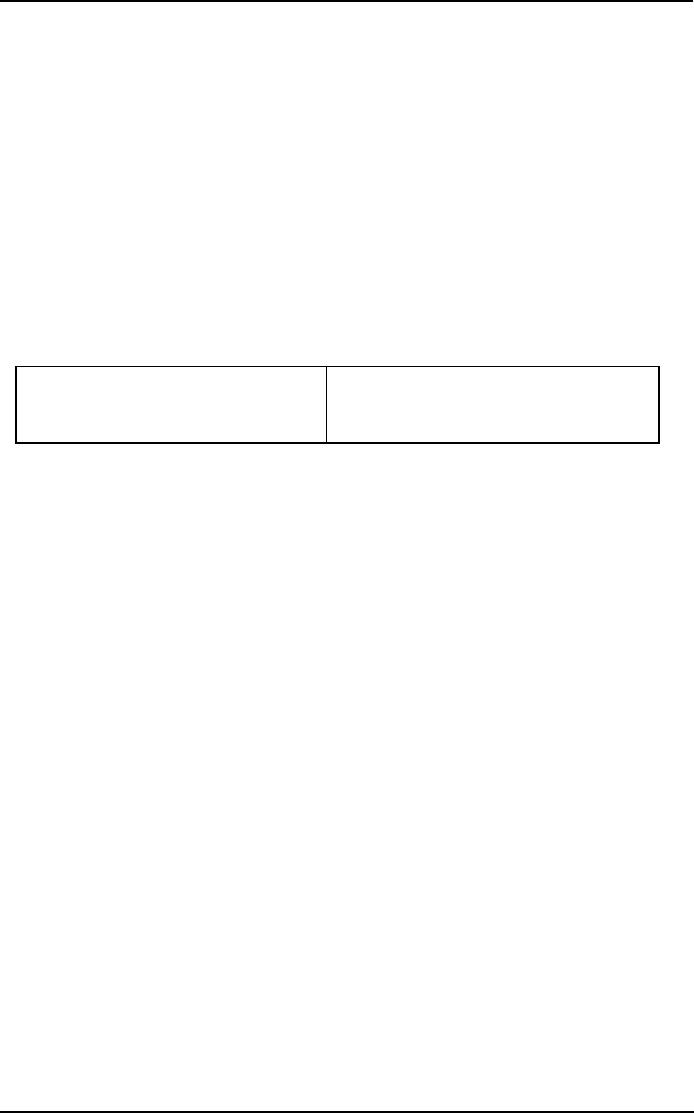 |

Leadership
& Team Management MGMT
623
VU
Lesson
16
BECOMING
A LEADER! WHAT DOES IT MEAN & HOW DO
YOU GET IT?
Leadership
is the exercise of influence by one
member of a group or organization
over other members
to
help the group or organization achieve
its goals. Formal leaders have
formal authority to
influence
others
by virtue of their job/position
responsibilities. Informal leaders
lack formal authority
but
influence
others by virtue of their special
skills or talents.
Becoming
a Leader:
The
leaders
of
a group, team or organization
are the individuals who
influence others behavior.
Leader
effectiveness
is the extent to which a leader actually
does help a group, team or
organization to achieve
its
goals. Leaders are either
appointed by someone external to the
group and they are elected by
group
members
themselves. Some people take
up role of leader by using their
influences. With the passage
of
time,
you can see that leadership
will emerge over time.
The group members will
assess with in the
group
that who is leader worthy. In
this situation, communication
style will play a dynamic
role. A
group
member can become a leader if he or
she has following
qualities/skills;
Share
your vision
Think
like a leader
Adapt
your style
Develop
your judgment
Pick
the right
followers
Build
leadership traits
Organize
tasks properly
Build
your power base
Foundations
of Leadership:
Vision:
Leaders
must have, and be able to communicate a
vision. Leaders must make
the followers see what
the
organization
can become and the success
that can be achieved. A Leader
must be effective that
actually
does
help a group, team or
organization to achieve its goals. An
effective leader helps achieve goals. An
ineffective
leader does not.
Mission
Statement:
Every
organization needs a mission statement,
which is a statement of the purpose of an
organization.
The
mission statement addresses the question:
What is the organization's reason
for being in
business?
It
broadly outlines the organization's
future course and communicates
"who we are, what we do,
and
where
we are headed. Mission
Statement describes purpose of the
organization;
WHAT
is expected to be achieved
WHY
is it worthwhile
HOW
it can be done
Defines
Core Values
Objectives:
Objectives
are desired outcomes for
individuals, groups, team or entire
organizations. The leaders
have
to
provide objectives--specific results
that he or she wants the
group to achieve. Planning is the
first
management
function, but by providing
direction, a manager becomes a
leader.
Direction:
A
leader must provide a direction
for achievement of the objectives to his
or her followers that
can
work
toward. A vision is especially
important in today's volatile
business environment.
Steps
to Leadership: The
following are the key steps
to leadership:
Identify
what is happening (identifying
areas requiring
leadership)
Account
for what is happening using
behavior science theories and
concepts
51

Leadership
& Team Management MGMT
623
VU
Formulate
leader actions based on your knowledge of
how to motivate employees and how
to
resolve
and manage inter-group
conflicts
Leading:
Leaders
must choose a style to suit
the situation in organization to achieve the
goals;
Employee
oriented: a leader may
have an employee oriented style
for its effective working
with in
the
group and team.
Participative:
a
leader may have participative style to
motivate other group members
to involve in
other
organizational activities or to motivate
employees to support each other in the achievement
of
organizational
goals.
Job
centered: a leader may
have job centered style to
play a hub role in the
organization.
Autocratic:
a
leader may have autocratic style
according to the organizational
environment exits.
The
other factors also play a
dynamic role to achieve the
organizational role. A leader
must;
Influence
organization culture: as we know
that the culture is the set
of values, norms and beliefs
define
by the organization environment or
management, a leader must influence on
the organizational
culture
for making a congenial
working environment.
Motivate:
Motivation
is a frequently used but
poorly understood in term dynamics. There
are over 140
definitions
of the term motivation that have been
used in various capacities. Motivation is
important
because
it explains why employees behave as they
do. Leaders need to understand
this so that they
must
motivate
the employees towards the organizational goals.
Influence
communication: Communication
is one of the most important processes
that take place in
organizations.
Effective communication allows
individuals, groups, teams and
organizations to achieve
their
goals and perform at a high level, and it
affects virtually every aspect of
organizational behavior.
Communication
is good or effective when
members of organization share
information with each
other
and
all parties involved are
relatively clear about what
information means. So leader must focus
on the
organizational
communication. Good communication
prevents many problems from occurring
and
serves
the following functions in an
organization.
Influence
the group: A leader
must have influence on the group or
team to achieve the organizational
goals.
If the leader loses the influence on
group or team he or she me
lose the game.
Have
leadership traits and power:
There
are so many traits of leader
ship which can not be
explained
and
varies from person to person
and style to style? But
each leader must make sure
the achievement of
organizational
goals in a best way.
Three
competency of a Leader: there are
three competency of leader;
Leading
the Organization:
Leading
the organization and put the organization
on right path through
setting vision, direction
and
strategy.
They also involve in problem
solving and decision making.
They keenly observe
the
prevailing
politics in the organization and
influence other team
members. Leaders always try
to create a
change
culture in the organization. For
this purpose they take the
risks and innovates the new things
in
the
organization by enhancing business skills
and knowledge.
Leading
others:
One
of the leader's competencies is leading
and managing others. In the
organization, a leader manages
the
effective teams and groups for
achievement of organizational objectives by
building and
maintaining
a working relationship between them. They
motivate other and build the trust on
team
members.
One of the major tasks of leader is to
develop other, which is more
important factor. They
set
a
reward system in the organization
and mostly link it with the
performance or achievement of goals.
Leading
oneself:
This
is also very important to
leading one self. It is the
responsibility of the leader to adopt the
changes
prevails
in the environment. They also
increase the self awareness
for himself that what is
going on in
52

Leadership
& Team Management MGMT
623
VU
the
surroundings of the organization. They
always try to lean as more as
they can. They also
develop
the
culture of ethics and integrity
with in the organization.
Developing
adaptability, increasing self-awareness,
managing yourself, increasing capacity to
learn,
exhibiting
leadership stature, displaying drive and
purpose, developing ethics and
integrity.
Leaders
always know about their
strengths, weakness, opportunities,
challenges and know who they
are
as
an individual. They also
know that "Positions do not
possess leadership characteristics, only
people
possess
leadership characteristics."
"Leadership
is not a matter of luck. The harder
you work, the luckier you
are."
53
Table of Contents:
- INTRODUCTION, ORGANIZATION THE STAGE FOR LEADERSHIP:Challenges, Value creation
- FOCUSING ON PEOPLE: THE KEY TO SUCCESS:People in the Process, Developing and Sustaining A World-class Workforce
- LEADERSHIP:Characteristics of Successful Leader, Why Study Leadership?
- LEADERSHIP (CONTD.):Characteristics of Leaders Who Fail, Why Leaders Fail?
- MANAGERS VS LEADERS:Characteristics, Effective Leadership, Respect for Diversity
- FOLLOWER-SHIP:Importance of Followers, Follower-ship Style
- LEADERSHIP PROCESS:Strategies for Cultivating Exemplary Followers, Important Traits of Leaders
- LEADERSHIP PROCESS (CONTD.):Qualities of Leaders, Self-Confidence, Integrity
- LEADERSHIP THEORIES/ APPROACHES:Personal Characteristics of Leaders, Managerial Grid
- CONTINGENCY THEORIES OF LEADERSHIP:The Fiedler Model, Situational Leadership Theory, Path-Goal Theory
- TRANSACTIONAL, CHARISMATIC AND TRANSFORMATIONAL LEADERSHIP:Visionary Leadership
- THE LEADER AS AN INDIVIDUAL:Personality, Situation, Heredity, Environment
- ATTITUDE-PERSONALITY:Job Satisfaction, Work Situation, Self - Monitoring
- BIG FIVE MODEL, MYERS BRIGGS TYPE INDICATOR (MBTI):Sub-Categories Defined, Information Gathering
- SITUATIONAL FACTORS:Social and psychological climate, Culture of the organization
- BECOMING A LEADER! WHAT DOES IT MEAN & HOW DO YOU GET IT?:Mission Statement, Leading oneself
- BECOMING A LEADER:Elements of Leadership, CONCEPT OF POWER,
- UNDERSTANDING POWER:Sources of Power, Responses to the Use of Power, Managing Political Behavior
- LEADERSHIP POWER & INFLUENCE:Positional Power, Being an Effective Leader
- LEADERSHIP AND EMPOWERMENT:Power sharing and Empowerment, Share Information
- MOTIVATION:Guidelines for Delegating, Human Resource Approach
- MOTIVATION AT WORK, MOTIVATION AND LEADERSHIP:What Factors Diminish Motivation in the Workplace
- LEADERSHIP COMMUNICATION:Communication & the Four Management Functions
- REVIEW-1:Organizational Performance, That is the Role of Management?, Leaders Vs Managers
- GROUP & TEAM CONCEPT:Groups versus Teams, Deciding When to Use a Team
- TEAM DYNAMICS:Stages of Group Development, Problem-Solving Teams, Benefits of Teams
- BUILDING THE TEAM:Leadership success requires, Strategies for Team Building
- A TEAM-BASED ORGANIZATION:Basic Steps, Span of Control, Categories of Decisions
- DECISION MAKING:Categories of Decisions, The Decision-Making Process
- TEAM DECISION MAKING:Team Problem Solving Techniques, Concept of QC
- EFFECTIVE TEAM COMMUNICATION:Team/Group Communications
- CONFLICT IN TEAM:Sources of Conflict, Scarcity of Resources, Dysfunctional Outcomes
- TRAINING/LEARNING OF TEAM:Training Methods, Phases of Learning Cycles
- LEARNING ORGANIZATION:A Litmus Test, Work Relations
- REWARDING & RECOGNIZING TEAMWORK:Compensating Teams, Individual or Team Rewards?
- MANAGING/LEADING VIRTUAL TEAMS:Communications in Virtual Organizations, Virtual Leadership
- EFFECTIVE TEAM MEETINGS:Better Meetings, Meeting Roles, Meeting Room Facilities
- LEADING TEAM:Team Leadership Structures, Leadership Demands and Duties, Leadership Direction
- REVIEW-II:Types of Teams, Characteristics of High Performance Teams, Sources of Conflict
- STRATEGIC LEADERSHIP:Strategic Management, Determining Strategic Direction, Developing Human Capital:
- LEADING CHANGE:Dynamics of Change, Change Models, Unfreeze
- CREATIVE LEADERSHIP:Awaken Your Senses, How Might These Definitions Be Integrated
- ETHICS IN LEADERSHIP:Character Traits Reflect Ethics, Manifests Honesty
- LOOKING AT THE FUTURE: WHAT COMES NEXT:Benefits of Teams, Ethical Leadership,
- TEAMWORK: LEARNING FROM NATURE:Social Behavior, Termites, Learning from Nature